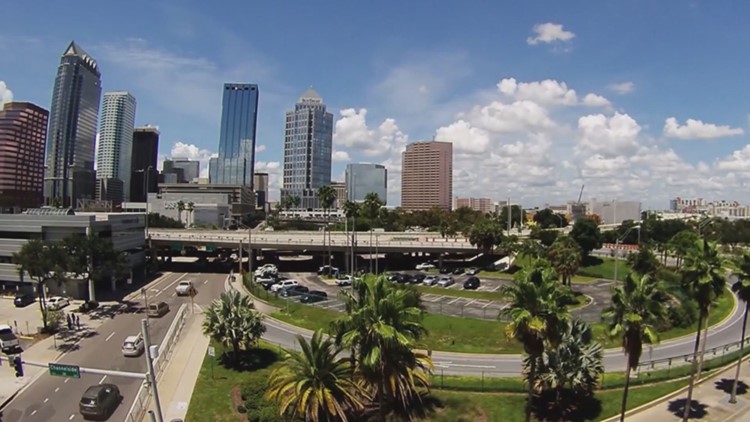ST. PETERSBURG, Fla. – It’s four-o-clock in the afternoon, you need to get across the bay, and you’re hopelessly trapped in gridlock on one of Tampa Bay’s busy bridges.
Sound familiar?
Traffic is one of the Tampa Bay area’s biggest issues despite various attempts to address it in recent years. As the region’s population has grown, the issue has compounded to the point where it may start to hurt the local economy, and depending on who you talk to, it may already be having a negative effect on growth.
However, state and federal plans to improve the area’s interstate infrastructure in the next few years, including a revamp on the Howard Frankland Bridge, could present the perfect opportunity for those looking to fix Tampa Bay’s transit problems.
“[Transit] has been, and will continue to be if we don’t do something about it, the Achilles heel that we as a region have when it comes to economic development, when it comes to corporations looking at us for potential sites for relocation, when it comes to quality of life and the impact on us as citizens,” said Tampa Mayor Bob Buckhorn. “It is the one area that we lag behind.”
Buckhorn has repeatedly talked about the need to address the transit issue during his time in office, to no avail.
“What really is lacking is the consensus and the political will to build a transportation plan, understanding that these projects are expensive. They’re certainly not free, and it’s going to take the politicians having faith in themselves and, more importantly, having faith in the voters,” Buckhorn added. “I think there are some elected officials that are more concerned about the next election and less concerned about the next generation. We know we have a problem, we see it every day, we live through it every day, we know that solutions are expensive.”
“We’ve got to start thinking differently,” Buckhorn said. “If we don’t do something and continue to just build roads as our only option, not only are we not going to solve the problem, we’re going to get deeper and deeper into the problem.”
One organization trying to do that is the Tampa Bay Area Regional Transit Authority [TBARTA], which currently has an online survey to help come up with the best regional transit plan for the area; One that not only offers options that people will choose to use over their own vehicles, but one that will fit the requirements for state and federal transit funding.
“This area really spends less on public transit than any of the other major communities in Florida and maybe, certainly, in the United States,” said Ramond Chiaramonte, who recently resigned as Executive Director for TBARTA to run for a district-wide commission office in Hillsborough County.
“One thing that’s different about us is we have a very challenging geography,” Chiaramonte added. “I’m not sure that we really ‘got it’ until recently that we do have 400 square miles of water right in the center of our metropolitan area called Tampa Bay, which makes us not Charlotte, not Jacksonville, not Orlando, not Houston.
“We’re different, so we have to have a transit system that fits us and not just say ‘Charlotte has light rail, that’s exactly what we need to do,'” he said. “They’re just one city and then suburbs. We have two major cities, Tampa and St. Petersburg, then you’ve got a bay in between them even though they’re only 20 miles apart."
Part of the solution might be what’s known as Bus Rapid Transit, which would involve dedicated lanes for buses to move freely, even during high-traffic times. Even with that, in order to convince people to get out of their cars and use public transit, those buses need to be comfortable and clean, run on regular, reliable schedules, and they need to easily accessible.
“We’re trying to get away from the word ‘bus’ because it really looks like rail,” Chiaramonte said. “It would operate like rail, but it would be in dedicated lanes and would be more of a rubber-tire vehicle; not our local buses, but more modern buses that they use in Europe and other places. Nobody’s really done a complete regional transit system using the kind of technology we’re talking about.”
“If we can get them [FDOT] to tweak the design of the modernization of the interstate to provide a dedicated lane, or at least a managed toll lane in some areas, we can play on that and use that for the transit but not have to pay for it with transit dollars,” he added. “So we can save a lot of money and get more bang for our buck.”
“Tampa Bay is behind the curve, we are of course congested as most growing metropolitan areas are, but we need to be careful,” said Dr. Steven Polzin, Director of Mobility Policy Research for the Center for Urban Transportation Research at the University of South Florida. “The need to do something is real if we want to continue to grow.”
“We do need to address the transportation issue, if it were simple we would have solved it a long time ago because there are a lot of people who have recognized it and been struggling to fix it and solve it. It isn’t easy,” added Dr. Polzin. “This community will need to spend more money, and then the real challenge is spending it wisely. Finding projects that make sense, that pencil out, that actually contribute to improving mobility.”
Meanwhile, Buckhorn said he already sees consequences when corporations decide to relocate to areas other than Tampa Bay because of the area’s transit inaction.
“When we get turned down we’ll go to them and say ‘where did we fall short?’, because we want to learn,” Buckhorn said. “In what is normally an exemplary report card the one area that we fall badly, badly behind Denver, behind Charlotte, behind some of our other competitors is the lack of mass transit. That, for us, will become the death nail over time if we don’t fix it, and if we don’t start that process now we get further and further behind the eight ball because the people are still coming.”
“These things are expensive, I get it,” he added. “But doing nothing is not a solution because doing nothing only exacerbates the problem, and gets us further and further behind to the point where it gets almost impossible for us to catch up.”
Phil Buck is a reporter with 10News WTSP. Like him on Facebook and follow him on Twitter. You can also email him at pbuck@wtsp.com.



